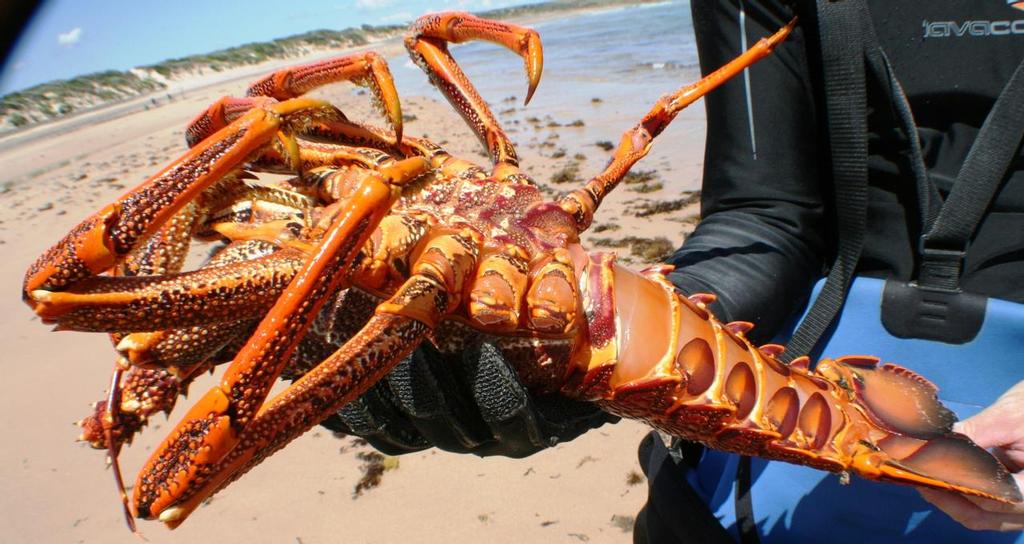Do not eat wild shellfish
by Carl Hyland on 27 Oct 2017

Tasmanian crayfish currently banned from consumption. Carl Hyland
Unfortunately, there is a major toxic algal bloom present along Tasmania’s East Coast which has prompted the following warning: Danger: Do not eat wild shellfish from the East Coast of Tasmania.
This Public Health Alert is current and applies to the entire East Coast.
Toxic algal blooms are present in Tasmanian waters.
High levels of algal toxins have been detected in shellfish in George Rocks, Binalong Bay, Bicheno, Great Oyster Bay, Great Swanport, Little Swanport, Spring Bay, Blackman Bay and Nubeena/Wedge Bay.
Because toxins have been detected in shellfish from the far north-east coast and as far south as Bruny Island, wild shellfish from anywhere along the East Coast may pose a risk.
Recreationally harvested shellfish from these waters should not be eaten because the algal toxins are harmful to humans.
Seek urgent medical help if you get sick after eating wild shellfish.
Symptoms can occur within minutes to hours after eating shellfish. Cooking or freezing the shellfish does not destroy the toxins that cause shellfish poisoning. Shellfish poisoning symptoms include:
• Tingling or numbness
• Weakness
• Blurred vision
• Difficulty breathing
• Vomiting
• Diarrhea.
Seafood in shops and restaurants is safe to eat because the
Tasmanian Shellfish Quality Assurance Program monitors the safety of commercially grown shellfish. Wild shellfish include: oysters, mussels, clams, pipis, cockles and wedge shells.
Abalone, scallop roes and the intestines and livers of rock lobster can also be affected when toxic algal blooms are present. View here for
DPIPWE’s Recreational Fishing Biotoxin Alerts.
Standard warning about wild shellfish
There is always a risk of illness after consuming wild shellfish harvested where water quality is poor. This is because water quality influences shellfish quality. For example, it is always unsafe to eat wild shellfish collected near:
• Marinas or other places where boats discharge waste
• Sewage, industrial or stormwater outfalls
• Areas with septic tanks
• Places affected by recent heavy rain
You can get gastro if you eat wild shellfish like oysters, mussels, clams, pipis, cockles and wedge shells.
Wild shellfish collected in Hobart’s Derwent Estuary and Launceston’s Tamar Estuary are always unsafe to eat.
Seek urgent medical help if you get sick after eating wild shellfish.
Seafood in shops and restaurants is safe to eat because the Tasmanian Shellfish Quality Assurance Program monitors the safety of commercially grown shellfish. This program is managed by the Department of Primary Industries, Parks, Water and Environment.
You risk becoming unwell when toxic algal blooms are present in the ocean. Toxic algal blooms are also known as harmful algal blooms. Please see the information below and check Public Health Alerts for the latest information on toxic algal blooms.
Background information
Toxic algal blooms: Some species of naturally occurring algae have been detected in eastern and southern Tasmanian waters over the past few years.
These algae can produce toxins that accumulate in shellfish that feed on the algae. Humans can ingest these naturally occurring toxins by eating shellfish such as oysters, mussels, scallops and clams.
Abalone, scallop roes and the intestines and livers of rock lobster can also be affected when toxic algal blooms are present. Visit DPIPWE’s Recreational Fishing Biotoxin Alerts.
The toxins can cause four types of human poisoning:
• Paralytic shellfish poisoning
• Amnesic shellfish poisoning
• Neurotoxic shellfish poisoning
• Diarrhetic shellfish poisoning
Symptoms can occur within minutes to hours after eating shellfish. Paralytic shellfish poisoning is the most common form of shellfish poisoning reported in Tasmania.
What causes toxic algal blooms?
Environmental conditions play an important role in the occurrence and spread of toxic algal blooms (also known as harmful algal blooms).
Ongoing research by the Institute for Marine and Antarctic Studies at UTAS and CSIRO is investigating the likely environmental triggers for the growth of species of harmful algae such as Alexandrium tamarense in Tasmanian coastal waters.
The following are being considered as possible bloom triggers:
• Cold water temperature windows of between 10C and 15C
• Rainfall/land-runoff
• Water column stratification (distinct layers of temperature and salinity in the water body with varying depth)
Researchers aim to use these triggers in the future in a predictive model for forecasting the occurrence of HABs.
Cooking or freezing the shellfish does not destroy the toxins that cause shellfish poisoning.
For more information about shellfish poisoning symptoms see pages 30-32 of the TSQAP Biotoxin Management Plan.
If you want to link to this article then please use this URL: www.sailworldcruising.com/158352